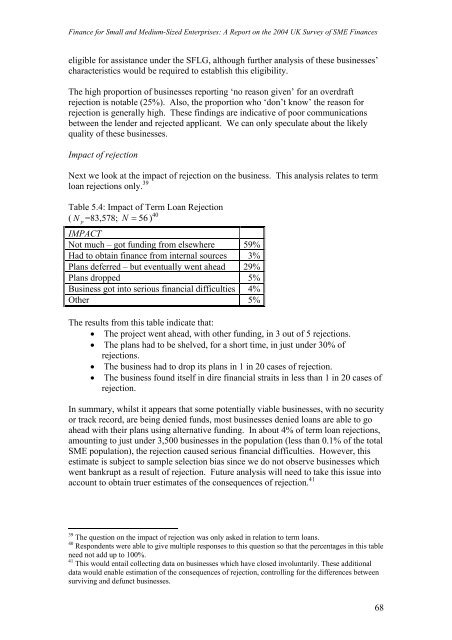Finance for Small and Medium-Sized Enterprises - DTI Home Page
Finance for Small and Medium-Sized Enterprises - DTI Home Page
Finance for Small and Medium-Sized Enterprises - DTI Home Page
Create successful ePaper yourself
Turn your PDF publications into a flip-book with our unique Google optimized e-Paper software.
<strong>Finance</strong> <strong>for</strong> <strong>Small</strong> <strong>and</strong> <strong>Medium</strong>-<strong>Sized</strong> <strong>Enterprises</strong>: A Report on the 2004 UK Survey of SME <strong>Finance</strong>s<br />
eligible <strong>for</strong><br />
assistance under the SFLG, although further analysis of these businesses’<br />
characteristics<br />
would be required to establish this eligibility.<br />
The high proportion of businesses reporting ‘no reason given’ <strong>for</strong> an overdraft<br />
rejection is notable (25%). Also, the proportion who ‘don’t know’ the reason <strong>for</strong><br />
reject ion is generally high. These findings are indicative of poor communications<br />
between the lender <strong>and</strong> rejected applicant. We can only speculate about the likely<br />
quality of<br />
these businesses.<br />
Impact<br />
of rejection<br />
Next we look at the impact of rejection on the business. This analysis relates to term<br />
loan rejections only. 39<br />
Table<br />
5.4: Impact of Term Loan Rejection<br />
40<br />
( N =83,578; N = 56 )<br />
p<br />
IMPACT<br />
Not much – got funding from elsewhere 59%<br />
Had to obtain finance from internal sources 3%<br />
Plans deferred – but eventually went ahead 29%<br />
Plans dropped 5%<br />
Business got into serious financial difficulties 4%<br />
Other 5%<br />
The results from this table indicate that:<br />
• The project went ahead, with other funding, in 3 out of 5 rejections.<br />
• The plans had to be shelved, <strong>for</strong> a short time, in just under 30% of<br />
rejections.<br />
• The business had to drop its plans in 1 in 20 cases of rejection.<br />
• The business found itself in dire financial straits in less than 1 in 20 cases of<br />
rejection.<br />
In summary, whilst it appears that some potentially viable businesses, with no security<br />
or track record, are being denied funds, most businesses denied loans are able to go<br />
ahead with their plans using alternative funding. In about 4% of term loan rejections,<br />
amounting to just under 3,500 businesses in the population (less than 0.1% of the total<br />
SME population), the rejection caused serious financial difficulties. However, this<br />
estimate is subject to sample selection bias since we do not observe businesses which<br />
went bankrupt as a result of rejection. Future analysis will need to take this issue into<br />
account to obtain truer estimates of the consequences of rejection. 41<br />
39<br />
The question on the impact of rejection was only asked in relation to term loans.<br />
40<br />
Respondents were able to give multiple responses to this question so that the percentages in this table<br />
need not add up to 100%.<br />
41<br />
This would entail collecting data on businesses which have closed involuntarily. These additional<br />
data would enable estimation of the consequences of rejection, controlling <strong>for</strong> the differences between<br />
surviving <strong>and</strong> defunct businesses.<br />
68















![Joint Report on Social Protection and Social Inclusion [2005]](https://img.yumpu.com/19580638/1/190x132/joint-report-on-social-protection-and-social-inclusion-2005.jpg?quality=85)
